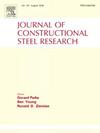拉伸载荷作用下WAAM 316L不锈钢螺栓连接的结构性能
IF 4
2区 工程技术
Q1 CONSTRUCTION & BUILDING TECHNOLOGY
引用次数: 0
摘要
本文研究了金属丝和电弧增材制造(WAAM)不锈钢螺栓连接的结构性能。对64个公称厚度为7mm和3mm的WAAM 316L不锈钢螺栓连接试件进行了轴向拉伸试验。采用三维激光扫描技术测量试件几何尺寸,采用数字图像相关(DIC)技术记录试件在试验过程中的整个变形过程。分析了端距、边距、螺栓直径、WAAM打印方向等关键参数对试件极限承载力和破坏模式的影响。为了评估现有设计标准的准确性,将得到的实验结果与现有设计规范(包括中国规范(CECS 410-2015)、美国规范(AISC 370-21)、欧洲规范(EN 1993-1-8)和美国规范(AISI S100-16)的预测值进行了比较。对比结果表明,试验结果与设计规范预测的设计强度之比的平均值为1.00 ~ 1.20。其中,AISC 370-21的平均比值比较准确。此外,目前的CECS 410-2015、AISC 370-21、EN 1993-1-8和AISI S100-16都不能准确预测螺栓连接的失效模式,预测准确率在37.5% ~ 65.6%之间。改进waam制造的不锈钢螺栓连接的设计方法仍然是一个需要进一步发展的重要领域。本文章由计算机程序翻译,如有差异,请以英文原文为准。
Structural behaviours of WAAM 316L stainless steel bolted connections under tensile loading
In this study, the structural behaviours of wire and arc additive manufacturing (WAAM) stainless steel bolted connections were investigated. A total of 64 WAAM 316L stainless steel bolted connection specimens with a nominal thickness of 7 mm and 3 mm were examined under axial tensile loads. The geometric dimensions of the specimens were measured using the 3D laser scanning technology, while the entire deformation process of the specimens during the tests was recorded using the digital image correlation (DIC) technology. The influences of key parameters, including the end distance, edge distance, bolt diameter, and WAAM printing direction, on the ultimate capacities and failure modes of the specimens were analyzed in this study. To evaluate the accuracy of the existing design standards, the obtained experimental results were compared against the predicted values by the existing design codes including Chinese code (CECS 410–2015), American code (AISC 370–21), European code (EN 1993-1-8) and American code (AISI S100–16). The comparison results indicated that the average ratio between the experimental results and the design strength predicted by the design codes ranges from 1.00 to 1.20. Among these, the average ratio for AISC 370–21 is relatively accurate. Additionally, the current CECS 410–2015, AISC 370–21, EN 1993-1-8, and AISI S100–16 are all unable to accurately predict the failure mode of bolted connections, with prediction accuracy rates ranging from 37.5 % to 65.6 %. Enhancing the design methods for WAAM-fabricated stainless steel bolted connections remains an essential area for further development.
求助全文
通过发布文献求助,成功后即可免费获取论文全文。
去求助
来源期刊

Journal of Constructional Steel Research
工程技术-工程:土木
CiteScore
7.90
自引率
19.50%
发文量
550
审稿时长
46 days
期刊介绍:
The Journal of Constructional Steel Research provides an international forum for the presentation and discussion of the latest developments in structural steel research and their applications. It is aimed not only at researchers but also at those likely to be most affected by research results, i.e. designers and fabricators. Original papers of a high standard dealing with all aspects of steel research including theoretical and experimental research on elements, assemblages, connection and material properties are considered for publication.
 求助内容:
求助内容: 应助结果提醒方式:
应助结果提醒方式:


